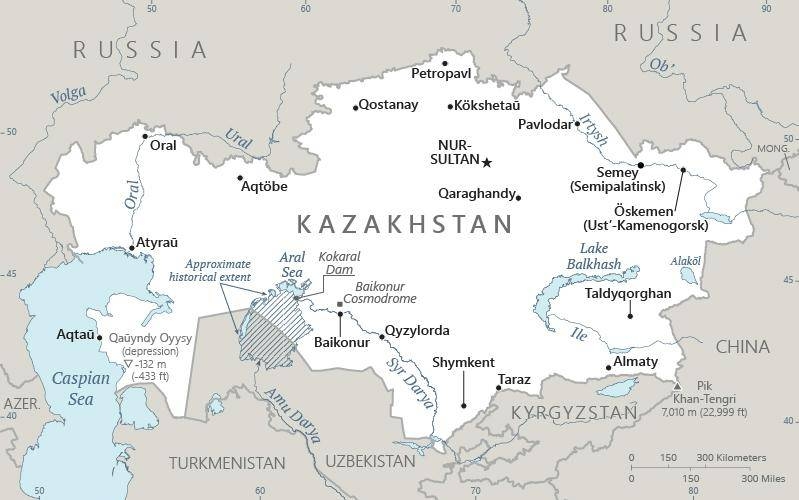Country Summary




Introduction
Background
Ethnic Kazakhs, a mix of Turkic and Mongol nomadic tribes with additional Persian cultural influences, migrated to the region in the 15th century. The area was conquered by Russia in the 18th and 19th centuries, and Kazakhstan became a Soviet Republic in 1925. The country gained independence in 1991.
Geography
Area
total: 2,724,900 sq km
land: 2,699,700 sq km
water: 25,200 sq km
Climate
continental, cold winters and hot summers, arid and semiarid
Natural resources
major deposits of petroleum, natural gas, coal, iron ore, manganese, chrome ore, nickel, cobalt, copper, molybdenum, lead, zinc, bauxite, gold, uranium
People and Society
Population
19,398,331 (2022 est.)
Ethnic groups
Kazakh (Qazaq) 68%, Russian 19.3%, Uzbek 3.2%, Ukrainian 1.5%, Uighur 1.5%, Tatar 1.1%, German 1%, other 4.4% (2019 est.)
Languages
Kazakh (official, Qazaq) 83.1% (understand spoken language) and trilingual (Kazakh, Russian, English) 22.3% (2017 est.); Russian (official, used in everyday business, designated the "language of interethnic communication") 94.4% (understand spoken language) (2009 est.)
Religions
Muslim 70.2%, Christian 26.2% (mainly Russian Orthodox), other 0.2%, atheist 2.8%, unspecified 0.5% (2009 est.)
Population growth rate
0.77% (2022 est.)
Government
Government type
presidential republic
Capital
name: Astana
Executive branch
chief of state: President Kasym-Zhomart TOKAYEV (since 20 March 2019)
head of government: Prime Minister Alikhan SMAILOV (since 11 January 2022); note - Prime Minister Askar MAMIN resigned on 5 January 2022 in the wake of massive protests of his government that began 2 January 2022 following a sudden, steep rise in gasoline prices
Legislative branch
description: bicameral Parliament consists of:
Senate (49 seats statutory, 48 as of October 2021); 34 members indirectly elected by 2-round majority vote by the oblast-level assemblies and 15 members appointed by decree of the president; members serve 6-year terms, with one-half of the membership renewed every 3 years)
Mazhilis (107 seats; 98 members directly elected in a single national constituency by proportional representation vote to serve 5-year terms and 9 indirectly elected by the Assembly of People of Kazakhstan, a 351-member, presidentially appointed advisory body designed to represent the country's ethnic minorities)
Economy
Economic overview
oil and gas giant, with growing international investment; domestic economy hit hard by COVID-19 disruptions; reforming civil society and improving business confidence; legacy state controls and Russian influence inhibit growth and autonomy
Real GDP (purchasing power parity)
$475.18 billion (2020 est.)
Real GDP per capita
$25,300 (2020 est.)
Agricultural products
wheat, milk, potatoes, barley, watermelons, melons, linseed, onions, maize, sunflower seed
Industries
oil, coal, iron ore, manganese, chromite, lead, zinc, copper, titanium, bauxite, gold, silver, phosphates, sulfur, uranium, iron and steel; tractors and other agricultural machinery, electric motors, construction materials
Exports
$51.75 billion (2020 est.)
Exports - partners
China 13%, Italy 12%, Russia 10%, Netherlands 7%, France 6%, South Korea 5% (2019)
Exports - commodities
crude petroleum, natural gas, copper, iron alloys, radioactive chemicals (2019)
Imports
$44.3 billion (2020 est.)
Imports - partners
Russia 34%, China 24% (2019)
Imports - commodities
packaged medicines, natural gas, cars, broadcasting equipment, aircraft (2019)
Exchange rates
tenge (KZT) per US dollar -
Page last updated: Tuesday, November 29, 2022
